Alice Springs (Page 3/3): Telegraph Station and The Original 'Spring'
Alice Springs Telegraph Station
Situated approximately 4km from the town centre, The Alice Springs Telegraph Station (ASTS) was one of 11 staffed repeater stations on the Overland Telegraph Line (OTL) which stretched 3178km across Australia from Adelaide to Port Darwin. The Alice Springs Station was at the midway point of the OTL and opened in 1872. From Port Darwin, a submarine cable continued to Singapore and beyond. The opening of the OTL played a pivotal role in Australia's development, opening up it's isolation from the rest of the world; whereas news, personal and business messages from/to Britain had taken 3 months to reach the Australians by sea, from 1872 onwards, it could now arrive by telegraph line within just a few hours.

In the early 1860's, in order to find new grazing country for Australia's pastoralists, the explorer John McDouall Stuart made three heroic attempts to cross the continent. In accomplishing this feat in 1862, his route was mostly followed a decade later by the OTL. South Australia's Postmaster General, Charles Todd was responsible for planning and constructing the OTL which with a six month delay in the northern end due to difficulties with the wet season, was eventually completed. On 21 October 1872, the first telegraph message was sent between Britain and Australia.

The ASTS was the first European settlement in Central Australia and the support it provided helped bring about further settlement in the region. By 1900, the ASTS was inhabited by a number of people including the Stationmaster and his family, a blacksmith/stockman, a cook, a governess and, of course, the telegraph linesmen/operators themselves. The role of the telegraph operators carried significant responsibility, listening to and repeating Morse code down the telegraph line containing confidential messages between Australia and the rest of the world. The Station operated until 1932. It later served as a home for Aboriginal children of mixed ancestry until 1963.

The old Telegraph Station in Alice Springs has been carefully restored and today is thus an important historical site which offers a glimpse into the towns European beginnings. The following photos show various points of interest to the visitor and are accompanied by brief descriptions beneath.
 |
 |
Above: The Stationmaster's Residence. This was built in 1888 and the finest dwelling in Central Australia at that time. The Stationmaster had a very important role for a number of reasons; as well as being in charge of the largest station on the OTL, he ran the region's Post Office, was Central Australia's only magistrate (he conducted court matters here)m was the government official responsible for Central Australian Aborigines and had several other roles including as an emergency doctor and selling rations to travellers. The north and south-facing shady verandas and thick walls, constructed of local stone, provided some protection from the extreme temperatures outside, although the interior would have been stifling during the long summers. The residence had a shared bedroom. The sitting room was used for entertaining and to welcome visitors to this remote outpost. The dining room used by the Station Master and his family contained solid chairs and a table which was more elaborate than in the simple room where other staff would eat. In general, furnishings would have been minimal though, as every item here had to be transported by camel from the nearest railway stop which was 500km away at the time at Oodnadatta in South Australia.
 |
 |
Above: The Stationmaster's Kitchen. This building originally opened as Central Australia's first post office in January 1878. In the late 1880's, the telegraph equipment was moved out and it became a kitchen. The building was originally divided into two; one side was used as a children's bedroom and sewing room for the Stationmaster's wife, where she made clothes for Aboriginal station workers and the other side was used as a kitchen, where she washed, ironed and cooked for the family and the governess. Other staff at the station had their meals prepared in the Barracks Kitchen.

 |
 |
|
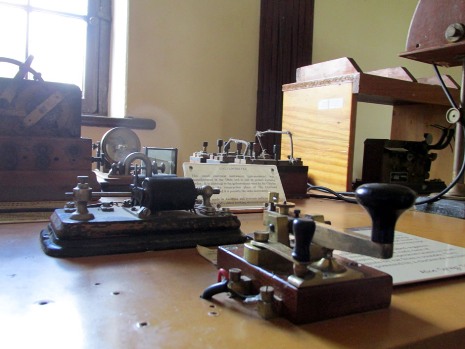 |
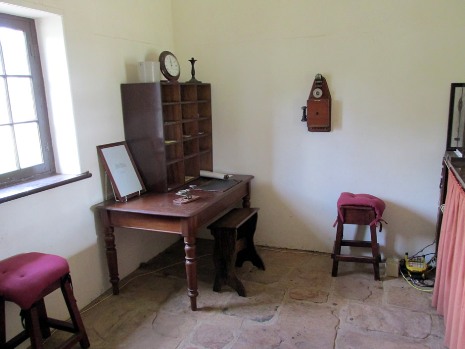 |
Above: The Post and Telegraph Office. Originally a house, this building became The Post and Telegraph Office in the late 1880's. This building was the heart of the Station. The Telegraph Office was manned throughout the day and night, due to the requirements of different time zones and the need to boost the Morse code signal as it was carried over vast distances. Inside, it is possible today to see the tables and various items of telegraph equipment as they would have been laid out during the days of operation. The Post Office next door in the same building would have been a lot quieter; the mail from South Australia only arrived every six weeks and until 1932, the few people living in the area would have come here to collect it or post outgoing items. The Post and Telegraph Office building later served as a hospital and clinic when the Station ceased operations and became an Aboriginal children's home.
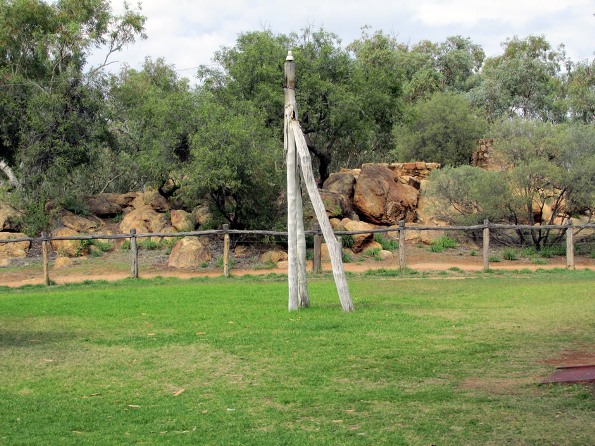 |
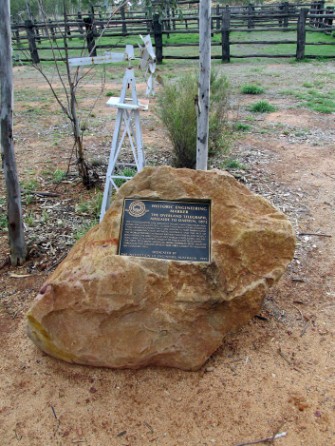 |

Above: A reconstruction of the Station's original evaporimeter. This was used to measure the local rate of evaporation and was constructed of one tank inside another, filled with water. The water in the outer tank kept the temperature of the inner one stable and also stopped animals drinking from it. As well as evaporation rates, other useful weather information was recorded at the Station; every four hours, thermometers, barometers and a wind strength gauge were also checked. The local weather information was then telegraphed to Adelaide and so the overland line meant scientists could now study daily weather patterns right across Australia.

Above: The shoeing yard at the side of the Blacksmith's Shop. Around the turn of the century (1895-1905), about sixty horses would have been kept on the Station . They were the only available transport and mainly used by linesmen who maintained the Telegraph Line. This area is next to the blacksmiths (below).
 |
 |
Above: The Blacksmith's Shop. One of the oldest buildings on the Station. It is possible to see inside the various items associated with a smithy. To heat the metal for shaping, near the front door, a fire would have been kept smouldering, brought to life when needed by bellows.

Above: The Battery Room. The building was originally constructed as sleeping quarters for the linesmen (c.1880) and in 1886, the building changed use and the batteries were relocated here from the Barracks. The Battery Room contained wet-cell batteries which were needed to power/boost the Alice Springs section of the OTL. Each of the wet-cell batteries covered a quarter of the buildings floor area; one would have been in use, one on standby and a third battery would have been recharging. All staff would have been trained on battery maintenance due to the essential requirement to keep the OTL running 24/7. When the Telegraph Station became an Aboriginal children's home in 1932, The Battery Room was converted into a schoolroom.
The thumbnail photo gallery above is of The Barracks. Construction began in November 1871 and it is the oldest building in Central Australia. Until 1878, the telegraph equipment was located here (the Station's first telegraph message being sent from here to Adelaide in January, 1872). With defence in mind, the building was designed like a fortress; the building's semi-enclosed courtyard has gun holes high in the walls, although the local Aborigines were peaceful and they were never needed. Modified over the years, a number of people would have slept here including telegraph operator's, the children, a teacher and the cook. Other rooms in the building were used for the schoolroom, the dining area for station staff (which doubled up as a court room, when needed), a storeroom, and the main kitchen. Today, where four rooms in The Barracks once stood, there is one long room which has a large timeline display running through it. The boards give much detail on the history of the Station and it is suggested for the visitor to head here first.
Above: Bungalow Dormitory. Outside the courtyard of The Barracks is a metal model representing the site where a large corrugated dormitory was built in 1932 when telegraph operations ceased and the site was then used as a home for Aboriginal children of mixed ancestry. It housed about 130 children whom had been taken from their Aboriginal mothers.
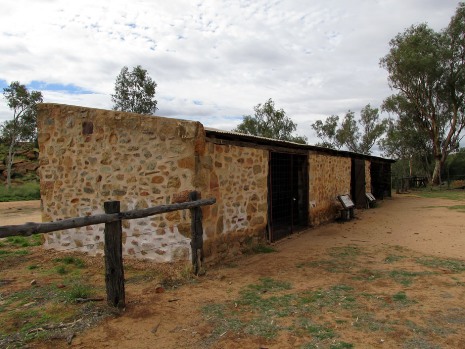 |
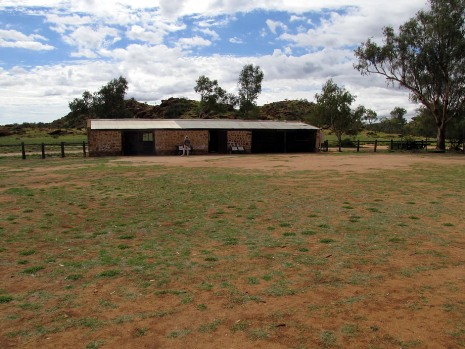 |
|
 |
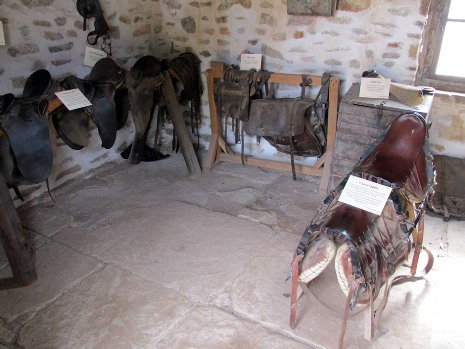 |
|
 |
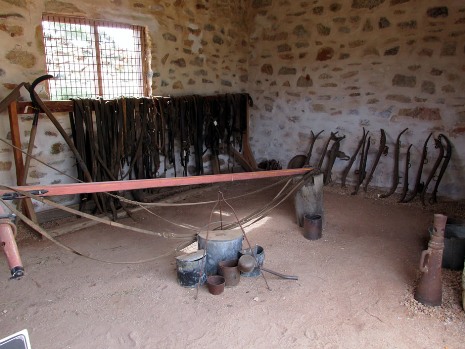 |
Above: Store and Buggy Shed. Built in the early 1870's, it was one of the Station's earliest buildings and used to store the Station's supplies (such as a year's worth of flour, tea and sugar) and to house horse-drawn buggies and associated accessories. The buggies carried people to and from the end of the railway line at Oodnadatta and for more local trips out. A cellar and flour store were also added later, but no longer in existence today. From 1932, the building was converted for the children's home use as a bathroom and laundry area.

Above: The Stockyards and Gallows. An account by Doris Bradshaw who lived at the Station from 1899-1908 states that 'a bullock was slaughtered once a week in winter and a sheep a day in summer when the cattle were too poor'. The bullock would have been slaughtered late in the day and left to hang on the gallow overnight to make the meat tender. It would then have been mostly corned or dried.
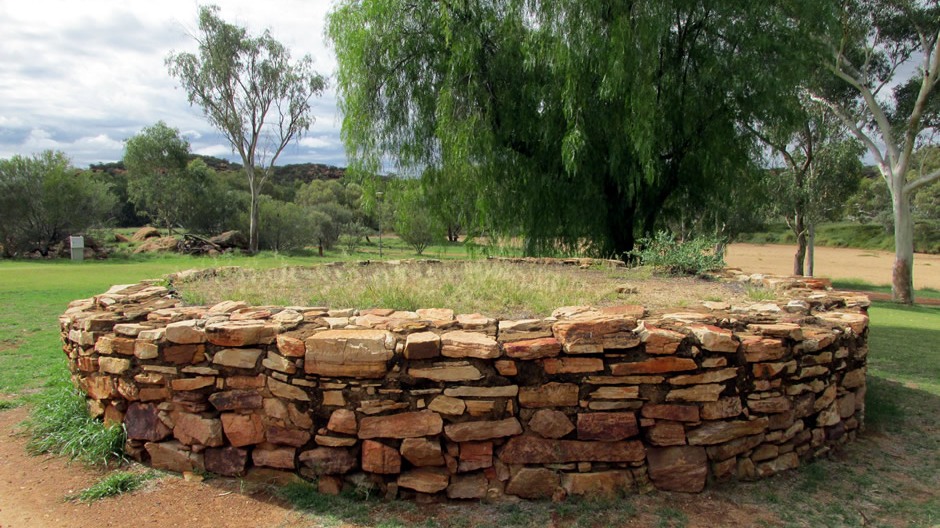
Above: Stone Tank Stand. This was installed during John McKay's time as Stationmaster (1908-1916) and was constructed to hold a 10,000 gallon water tank. The tank itself, which supplied water for station staff and to a horse trough, was transported in kit form and assembled on site with walls made of galvanised iron. By the time this tank was put in place, mechanical pumps powered by paraffin or kerosene had been developed and these were used to draw water from the riverbed. Prior to this, a whip would have been used (a counterweight arrangement with a long pole mounted like a seesaw, ropes and a bucket).

Above: A River Red Gum tree stands between The Stationmaster's Kitchen (left) and The Barracks (right). The tree is about the same age as the Overland Telegraph Line (built 1870-1872).
Thereyurre - The Original 'Alice' Spring
Adjacent to the Alice Springs Telegraph Station lies the original 'Alice' spring, known to the Arrernte Aboriginal people as Thereyurre. This is a semipermanent waterhole in the Todd River which the town was named after in 1933 by popular demand (the town's original name was Stuart). Prior to the arrival of Europeans, the Eastern Arrernte Aboriginal people had already been inhabiting the area around the Lhere Mparntwe (Todd River) for 20,000 years. The semipermanent waterhole and nearby soakages provided water for large groups of people, who would meet here for ceremonies and to exchange goods.
William Whitfield Mills, the overseer of a telegraph line construction party, named the waterhole after Mrs Alice Todd after coming across it on 11th March 1871. Mrs Alice Todd was the wife of the South Australian Postmaster General and never actually visited Alice Springs herself. Rivers in Central Australia, such as the Todd River here, run upside down and so whilst the river may look dry, there's actually water down below. Here, it is quite close to the surface and so was a vital resource for the Alice Springs Telegraph Station; in order to run through what William Whitfield Mills described as "... a pass, and springs...", the original planned route of the Telegraph Line was modified a decade after Stuart's survey which ran 45km west of here.
 |
||
Contrary to what the name suggests, the original 'Alice' spring isn't actually a spring, rather a depression in the riverbed where water gets trapped on top of some granite. It was a mistaken belief that the water here was fed from a spring in the hillside behind where the water appears. Although the water is not always visible, it is still there, under the sand. As a point of note, although the water is not visible in the photos above, the night before they were taken there was a heavy downpour of rain in Alice Springs. When William Whitfield Mills arrived here in 1871, he found the waterhole at a time when heavy rain had fallen in the weeks before his arrival.
The site of Alice Springs Telegraph Station and Thereyurre (The Original 'Alice' Spring) is set in 450 hectares of parkland, which makes for a great place to Picnic or have a BBQ. There are a number of mountain bike trails which can be taken and eight marked walking trails. The walking trails include the popular loop Trig Hill Walk (1.2km) which offers 360° views of the station and surrounding MacDonnell Ranges, Alice Springs Waterhole Walk (200m), Cemetery Walk (1.4km) which takes you to the grave of five early residents of Central Australia, Riverside Walk (1.8km) and for the experienced walker, from here is section 1 of the Larapinta Trail (23.8km/1-2 days). Sections 2-12 of the Larapinta Trail continue a further 223km of varying grades of difficulty and take in some of the main attractions of the West MacDonnell Ranges (Tyerretye), ending up at Mt Sonder, the trail's highest peak.
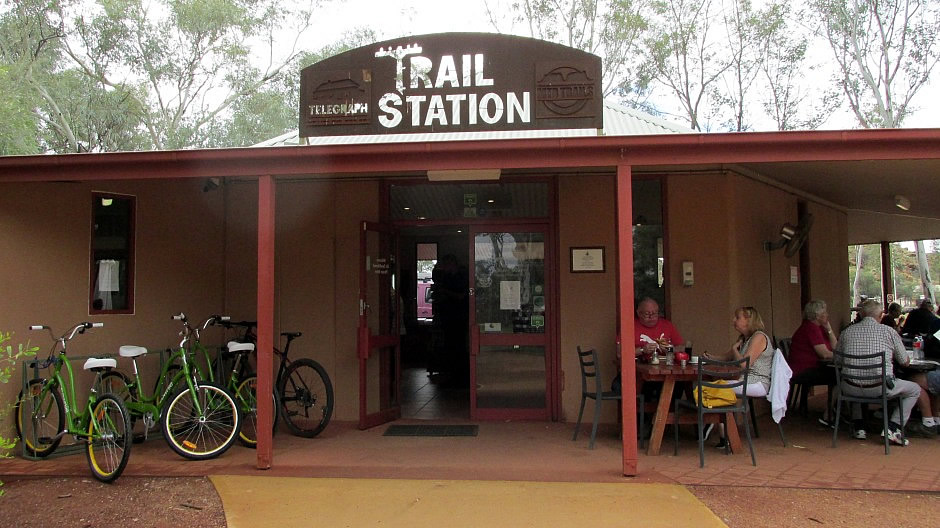
References and Further Reading
1. Exploring the Stuart Highway and Oodnadatta
Track Adelaide to Darwin. Balhannah, SA: Tourist Information
Distributors Australia.
2. In situ public information boards and
literature
3. Rawlings-Way, C., Worby, M. and Brown, L. (2013). Central
Australia. Footscray, Vic.: Lonely Planet.
4. The Royal Flying Doctor
Service on Wikipedia
Here
5. Red Centre - Alice Springs to Uluru (Map with
visitor information). Hema Maps Pty Ltd.
Back to Page 1 (Anzac Hill and The Town)
Back to Page 2 (School of the Air and The Royal Flying Doctor Service)